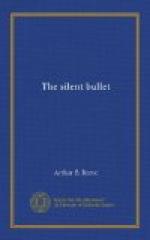Kennedy snapped a little announcer such as lecturers use. “Let me invite your attention to these enlargements of finger-prints,” he began, as a huge thumb appeared on the screen. “Here we have a series of finger-prints which I will show one after another slowly. They are all of the fingers of the same person, and they were found on some empty bottles of spring water used at Bisbee Hall during the two weeks previous to the departure of Mr. Bisbee for New York.
“Here are, in succession, the finger-prints of the various servants employed about the house—and of a guest,” added Craig, with a slight change of tone. “They differ markedly from the finger-prints on the glass,” he continued, as one after another appeared, “all except this last one. That is identical. It is, Inspector, what we call a composite type of finger-print—in this case a combination of what is called the ‘loop’ and ‘whorl’ types.”
No sound broke the stillness save the sputtering of the oxygen on the calcium of the stereopticon.
“The owner of the fingers from which these prints were made is in this room. It was from typhoid germs on these fingers that the fever was introduced into the drinking water at Bisbee Hall.”
Kennedy paused to emphasise the statement, then continued. “I am now going to ask Dr. Leslie to give us a little talk on a recent discovery in the field of typhoid fever—you understand, Commissioner, what I mean, I believe?”
“Perfectly. Shall I mention names?”
“No, not yet.”
“Well,” began Dr. Leslie, clearing his throat, “within the past year or two we have made a most weird and startling discovery in typhoid fever. We have found what we now call ’typhoid carriers’—persons who do not have the disease themselves, perhaps never have had it, but who are literally living test-tubes of the typhoid bacillus. It is positively uncanny. Everywhere they go they scatter the disease. Down at the department we have the records of a number of such instances, and our men in the research laboratories have come to the conclusion that, far from being of rare occurrence, these cases are comparatively common. I have in mind one particular case of a servant girl, who, during the past five or six years, has been employed in several families.
“In every family typhoid fever has later broken out. Experts have traced out at least thirty, cases and several deaths due to this one person. In another case we found an epidemic up in Harlem to be due to a typhoid carrier on a remote farm in Connecticut. This carrier, innocently enough, it is true, contaminated the milk-supply coming from that farm. The result was over fifty cases of typhoid here in this city.
“However, to return to the case of the servant I have mentioned. Last spring we had her under surveillance, but as there was no law by which we could restrain her permanently she is still at large. I think one of the Sunday papers at the time had an account of her—they called her ‘Typhoid Bridget,’ and in red ink she was drawn across the page in gruesome fashion, frying the skulls of her victims in a frying-pan over a roaring fire. That particular typhoid carrier, I understand—”




